Diploma in Education and Training Task 2022
Analyse the pedagogical principles and theories of behaviour management in education and training, and design resources to support the delivery model.
40 Pages9100 Words94 Views
Added on 2022-08-29
Diploma in Education and Training Task 2022
Analyse the pedagogical principles and theories of behaviour management in education and training, and design resources to support the delivery model.
Added on 2022-08-29
ShareRelated Documents
Running head: Diploma in education and training
Diploma in education and training
Name of the Student
Name of the University
Author note
Diploma in education and training
Name of the Student
Name of the University
Author note
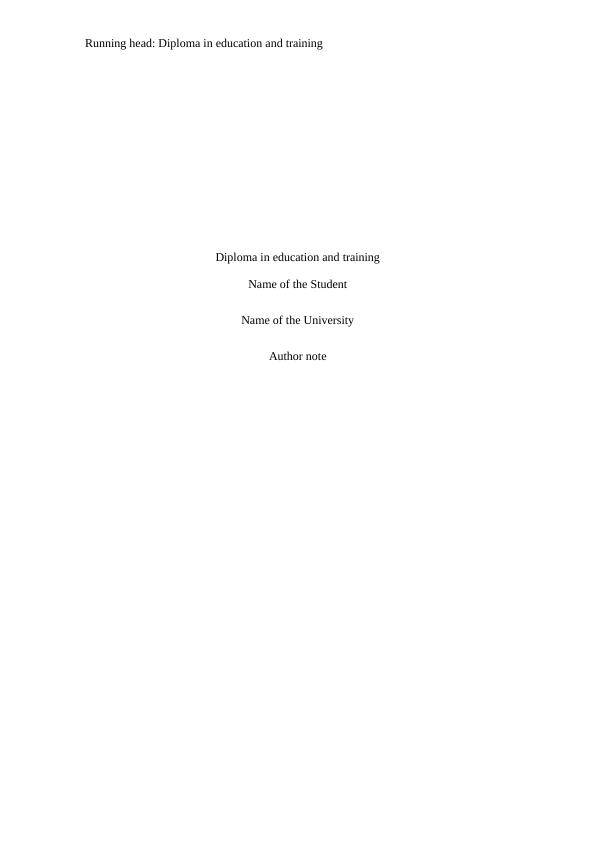
Diploma in education and training1
Table of Contents
Task 1a..............................................................................................................................4
Behaviour Management..............................................................................................4
Explain the importance of behaviour management in the classroom....................4
Analyse at least 4 pedagogical principles of behaviour management. Pedagogical
principles: e.g. concepts of specialist knowledge, experiential learning,
kinaesthetic principles, multisensory models, the taxonomy of learning, mastery
learning, scaffolded learning, actively engaging in the learning process & shared
outcomes.......................................................................................................................5
Analyse other principles of behaviour management for group and individual
behaviour management...............................................................................................7
Analyse the theories of behaviour management.......................................................8
Task 3..............................................................................................................................11
c. Use the diagnostic or initial assessment to agree and record at least TWO
learners’ individual goals and learning preferences..............................................11
d. To support the selected delivery model you need to design THREE different
resources:....................................................................................................................11
Task 5B...........................................................................................................................12
b. Use your research and practical examples to provide a written analysis of the
role and use of initial and diagnostic assessment in agreeing individual learning
goals with your learners. Explain why it is important to identify and meet the
individual needs of your selected learners. (Approximately 1500 words.)...........12
Table of Contents
Task 1a..............................................................................................................................4
Behaviour Management..............................................................................................4
Explain the importance of behaviour management in the classroom....................4
Analyse at least 4 pedagogical principles of behaviour management. Pedagogical
principles: e.g. concepts of specialist knowledge, experiential learning,
kinaesthetic principles, multisensory models, the taxonomy of learning, mastery
learning, scaffolded learning, actively engaging in the learning process & shared
outcomes.......................................................................................................................5
Analyse other principles of behaviour management for group and individual
behaviour management...............................................................................................7
Analyse the theories of behaviour management.......................................................8
Task 3..............................................................................................................................11
c. Use the diagnostic or initial assessment to agree and record at least TWO
learners’ individual goals and learning preferences..............................................11
d. To support the selected delivery model you need to design THREE different
resources:....................................................................................................................11
Task 5B...........................................................................................................................12
b. Use your research and practical examples to provide a written analysis of the
role and use of initial and diagnostic assessment in agreeing individual learning
goals with your learners. Explain why it is important to identify and meet the
individual needs of your selected learners. (Approximately 1500 words.)...........12
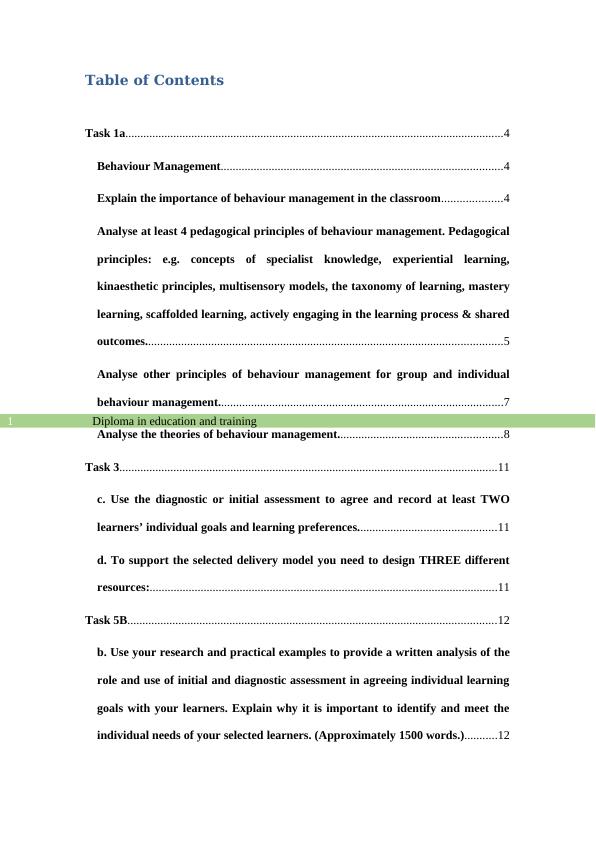
Diploma in education and training2
Evidence: Learning...................................................................................................15
Task 8..............................................................................................................................16
Undertake a piece of individual research into different theories of
communications and the impact on learning. You could include Piaget,
Bernstein and Vygotsky as starting places for your research...............................16
Use your individual research to produce a written report, using examples taken
from your own teaching practice, to analyse the benefits and limitations of the
communication methods you use.............................................................................16
Theories......................................................................................................................17
Theory of Eric Burns.............................................................................................19
Shannon and weaver communication model......................................................19
Task 11a..........................................................................................................................20
GENERIC - Produce a table listing a minimum of 10 different types of
assessment and against each type briefly explain the purpose and the assessment
outcome (include an introduction on definition of assessment and the types of
assessment.)................................................................................................................20
Task 11b.........................................................................................................................23
REFLECTIVE (from task 11a) - Use research to help your understanding or
assessment, and referring to the practical examples from your teaching practice
observations, provide a written report to analyse the effectiveness of the
assessment methods, used in your specialist area, in meeting the individual needs
of your learners - (Approximately 1500 words)......................................................23
Evidence: Learning...................................................................................................15
Task 8..............................................................................................................................16
Undertake a piece of individual research into different theories of
communications and the impact on learning. You could include Piaget,
Bernstein and Vygotsky as starting places for your research...............................16
Use your individual research to produce a written report, using examples taken
from your own teaching practice, to analyse the benefits and limitations of the
communication methods you use.............................................................................16
Theories......................................................................................................................17
Theory of Eric Burns.............................................................................................19
Shannon and weaver communication model......................................................19
Task 11a..........................................................................................................................20
GENERIC - Produce a table listing a minimum of 10 different types of
assessment and against each type briefly explain the purpose and the assessment
outcome (include an introduction on definition of assessment and the types of
assessment.)................................................................................................................20
Task 11b.........................................................................................................................23
REFLECTIVE (from task 11a) - Use research to help your understanding or
assessment, and referring to the practical examples from your teaching practice
observations, provide a written report to analyse the effectiveness of the
assessment methods, used in your specialist area, in meeting the individual needs
of your learners - (Approximately 1500 words)......................................................23

Diploma in education and training3
Explain how each is effectively used in your practice, how they met the needs of
a particular learner and how they can be improved..............................................23
Reflection and assessment types in my practise......................................................25
SWOT Analysis..........................................................................................................27
Explain how each is effectively used in your practice, how they met the needs of
a particular learner and how they can be improved..............................................23
Reflection and assessment types in my practise......................................................25
SWOT Analysis..........................................................................................................27
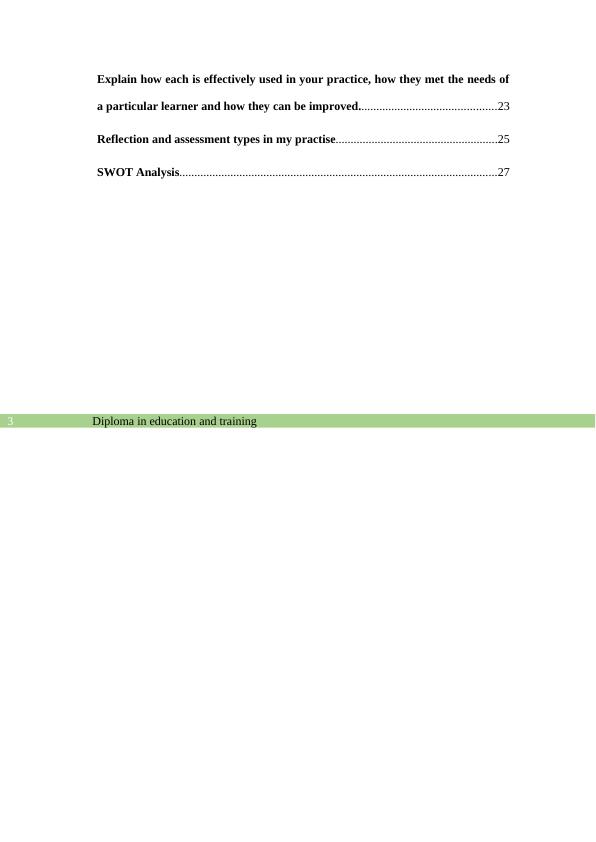
Diploma in education and training4
Task 1a
Behaviour Management
Behaviourism is a concept that is defined as an idea that human behaviour could
be manipulated and changed through various forms of interventions. This theory arises
from an experiment by psychologist Ivan Pavlov where he showed that a dog’s
behaviour could be affected by the use of sensory stimuli such as ringing bells. He
observed that if he rang a bell every time he fed the dog, the dog eventually began
expecting food every time he rang the bell. This was evident because the dog would
drool every time the bell rang. The theory involving this connection that was formed
between the two actions and the consecutive conditioning of the dog was developed by
Pavlov and is popularly known as Operant Conditioning (Bentley, T. 2012).
Another psychologist known for dealing with operant conditioning is
B.F.Skinner. He has theorized that positive and negative reinforcements could be used
to manipulate behaviour differently. His experiment involved rats which, when given
food, showed a positive change in mood. However, when subjected to negative
reinforcements such as electric shock, they showed a different change in mood (Skinner,
B. 2013). This theory could be applicable in a current office space where positive
reinforcements such as promotions could be given in order to boost motivation and
work capacity (Bills, D. 2013).
Behaviour management refers to the actions and steps that are taken in order to
maintain a particular behaviour in a person. This is close to behavioural therapy, but is
rather a less intense variant of it in comparison with other similar areas like behaviour
modification. Behaviour management can therefore be summed up as the actions and
strategies that are employed in order to make sure that the people adopt behavioural
Task 1a
Behaviour Management
Behaviourism is a concept that is defined as an idea that human behaviour could
be manipulated and changed through various forms of interventions. This theory arises
from an experiment by psychologist Ivan Pavlov where he showed that a dog’s
behaviour could be affected by the use of sensory stimuli such as ringing bells. He
observed that if he rang a bell every time he fed the dog, the dog eventually began
expecting food every time he rang the bell. This was evident because the dog would
drool every time the bell rang. The theory involving this connection that was formed
between the two actions and the consecutive conditioning of the dog was developed by
Pavlov and is popularly known as Operant Conditioning (Bentley, T. 2012).
Another psychologist known for dealing with operant conditioning is
B.F.Skinner. He has theorized that positive and negative reinforcements could be used
to manipulate behaviour differently. His experiment involved rats which, when given
food, showed a positive change in mood. However, when subjected to negative
reinforcements such as electric shock, they showed a different change in mood (Skinner,
B. 2013). This theory could be applicable in a current office space where positive
reinforcements such as promotions could be given in order to boost motivation and
work capacity (Bills, D. 2013).
Behaviour management refers to the actions and steps that are taken in order to
maintain a particular behaviour in a person. This is close to behavioural therapy, but is
rather a less intense variant of it in comparison with other similar areas like behaviour
modification. Behaviour management can therefore be summed up as the actions and
strategies that are employed in order to make sure that the people adopt behavioural
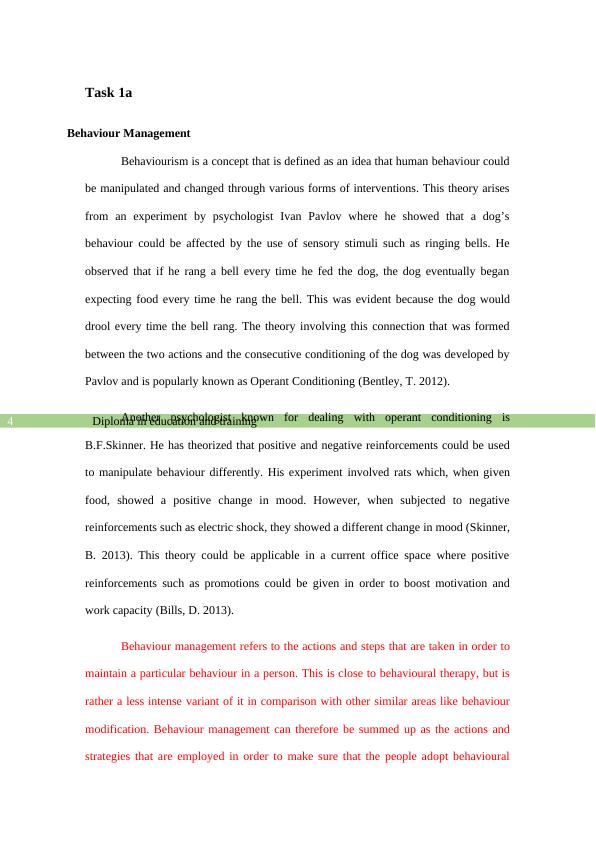
Diploma in education and training5
traits that are fulfilling, productive as well as socially appropriate (Hart 2010). In
classroom contexts, it becomes important as most behaviour management principles and
practices can be applied to ensure that the negative and unacceptable behaviour on the
part of the students are kept under check and the positive and productive behavioural
traits are managed.
Explain the importance of behaviour management in the classroom
It is possible to apply the theories of operant conditioning in managing
behaviour of students in the classroom. Behaviour management is necessary in a
classroom as it promotes better environment for learning. It was common for teachers to
use sticks and canes before the age of political correctness in class as a negative
reinforcement against bad behaviour. But this has been found to be detrimental to the
psychology of students, especially children who could be scarred for life from trauma.
However, as this practice came to an end, a system of imposing detentions and negative
points began as a new method of instilling discipline among students.
It has been observed that it is beneficial for students to receive negative as well
as positive reinforcements in order for them to maintain good behaviour. Students could
be presented awards, good grades, and other benefits as positive reinforcement when
their behaviour is considered good. For example, an individual could be awarded extra
leisure time for good behaviour whereas bad behaviour could earn one detention time in
school (Black, P. and William, D. 2013).
However, one must remember that human beings are not purely animalistic and
not all psychological behavioural experiments which have proven to be successful on
other animals would show similar and expected results when applied to humans. Only
traits that are fulfilling, productive as well as socially appropriate (Hart 2010). In
classroom contexts, it becomes important as most behaviour management principles and
practices can be applied to ensure that the negative and unacceptable behaviour on the
part of the students are kept under check and the positive and productive behavioural
traits are managed.
Explain the importance of behaviour management in the classroom
It is possible to apply the theories of operant conditioning in managing
behaviour of students in the classroom. Behaviour management is necessary in a
classroom as it promotes better environment for learning. It was common for teachers to
use sticks and canes before the age of political correctness in class as a negative
reinforcement against bad behaviour. But this has been found to be detrimental to the
psychology of students, especially children who could be scarred for life from trauma.
However, as this practice came to an end, a system of imposing detentions and negative
points began as a new method of instilling discipline among students.
It has been observed that it is beneficial for students to receive negative as well
as positive reinforcements in order for them to maintain good behaviour. Students could
be presented awards, good grades, and other benefits as positive reinforcement when
their behaviour is considered good. For example, an individual could be awarded extra
leisure time for good behaviour whereas bad behaviour could earn one detention time in
school (Black, P. and William, D. 2013).
However, one must remember that human beings are not purely animalistic and
not all psychological behavioural experiments which have proven to be successful on
other animals would show similar and expected results when applied to humans. Only
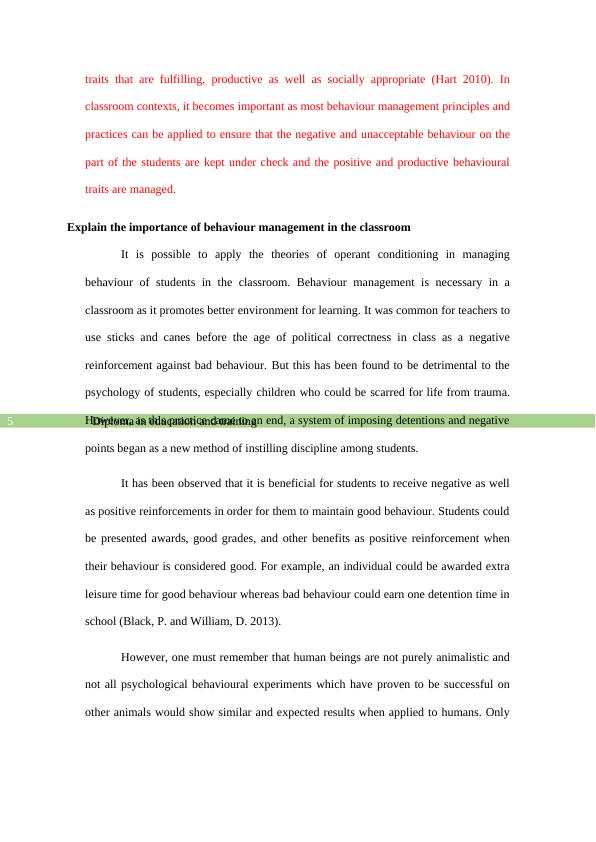
Diploma in education and training6
assumptions could be made about the theories and their significance in human
behaviour.
Analyse at least 4 pedagogical principles of behaviour management. Pedagogical
principles: e.g. concepts of specialist knowledge, experiential learning, kinaesthetic
principles, multisensory models, the taxonomy of learning, mastery learning,
scaffolded learning, actively engaging in the learning process & shared outcomes.
Pedagogical principles constitute the various methods and the ideas behind
them, which are applied during teaching.
Specialist knowledge
This principle states that a sound grasp of the subject knowledge is something
that promotes respect and confidence among students for the teacher, which in turn
benefits the teacher by helping him or her understand the students better. The inspiration
comes among students to assimilate knowledge when the teacher is a specialized
individual in the respective field. Therefore, according to Harrison (2002), the teacher’s
proficiency helps making difficult concepts easier to students and thereby creating
curiosity to learn more.
Kinaesthetic principle
This kind of learning generally involves tactile learning, where sensations and
touch is given precedence over sight and audition. This method could be especially
beneficial for special needs students, who may suffer from various disorders such as
assumptions could be made about the theories and their significance in human
behaviour.
Analyse at least 4 pedagogical principles of behaviour management. Pedagogical
principles: e.g. concepts of specialist knowledge, experiential learning, kinaesthetic
principles, multisensory models, the taxonomy of learning, mastery learning,
scaffolded learning, actively engaging in the learning process & shared outcomes.
Pedagogical principles constitute the various methods and the ideas behind
them, which are applied during teaching.
Specialist knowledge
This principle states that a sound grasp of the subject knowledge is something
that promotes respect and confidence among students for the teacher, which in turn
benefits the teacher by helping him or her understand the students better. The inspiration
comes among students to assimilate knowledge when the teacher is a specialized
individual in the respective field. Therefore, according to Harrison (2002), the teacher’s
proficiency helps making difficult concepts easier to students and thereby creating
curiosity to learn more.
Kinaesthetic principle
This kind of learning generally involves tactile learning, where sensations and
touch is given precedence over sight and audition. This method could be especially
beneficial for special needs students, who may suffer from various disorders such as
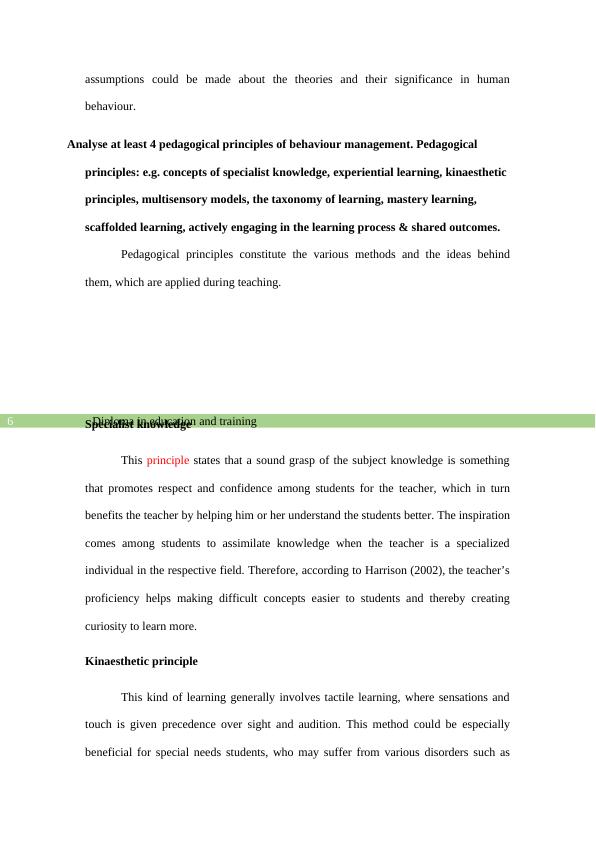
Diploma in education and training7
dyslexia, blindness, autism and more. According to expert Rita Dunn, kinaesthetic
learning helps students to take a more tactile approach to learning (Searson & Dunn
2001).
Taxonomy of learning
This theory was propounded by Bloom (1964). He argued that learning occurs in
several steps or hierarchies. These are: remember, understand, apply, analyse, evaluate
and create. The first step, remembering, involves recalling rudimentary ideas and facts.
The next steps involve complex thought which leads to the comprehension of more
complicated and related concepts. Eventually these steps when combined and applied, it
leads to creation. Blaire (2014) further stated that the application and appraisal of new
ideas require more skill sets.
Scaffolded learning
Scaffolding could be defined as providing support to learning in students. This
principle is applied when students have difficulty in understanding concepts and the
teacher assists by providing extra resources during lessons to aid learning. Student-
centred learning is the key focus in scaffolding learning. The rudimentary knowledge
dyslexia, blindness, autism and more. According to expert Rita Dunn, kinaesthetic
learning helps students to take a more tactile approach to learning (Searson & Dunn
2001).
Taxonomy of learning
This theory was propounded by Bloom (1964). He argued that learning occurs in
several steps or hierarchies. These are: remember, understand, apply, analyse, evaluate
and create. The first step, remembering, involves recalling rudimentary ideas and facts.
The next steps involve complex thought which leads to the comprehension of more
complicated and related concepts. Eventually these steps when combined and applied, it
leads to creation. Blaire (2014) further stated that the application and appraisal of new
ideas require more skill sets.
Scaffolded learning
Scaffolding could be defined as providing support to learning in students. This
principle is applied when students have difficulty in understanding concepts and the
teacher assists by providing extra resources during lessons to aid learning. Student-
centred learning is the key focus in scaffolding learning. The rudimentary knowledge
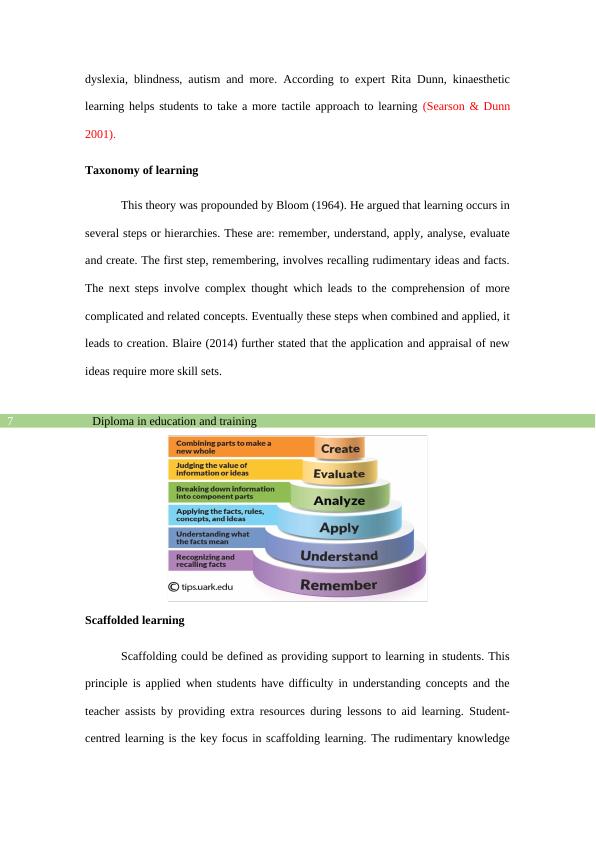
End of preview
Want to access all the pages? Upload your documents or become a member.
Related Documents
Developing teaching, learning and assessment in education and traininglg...
|21
|7846
|1
Developing Teaching, Learning and Assessment in Education and Traininglg...
|18
|5571
|2
Analysis of theories and models of curriculum and development Assignment PDFlg...
|17
|5179
|250
Developing Teaching Learning and Assessment in Education and Traininglg...
|22
|6286
|9
Developing Teaching, Learning, and Assessment in Education and Traininglg...
|16
|4392
|451
Theories, Principles and Models in Education & Traininglg...
|23
|8515
|438
